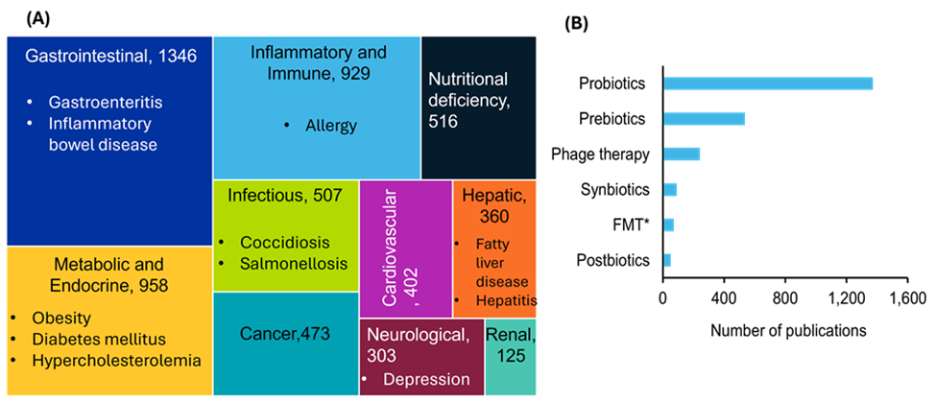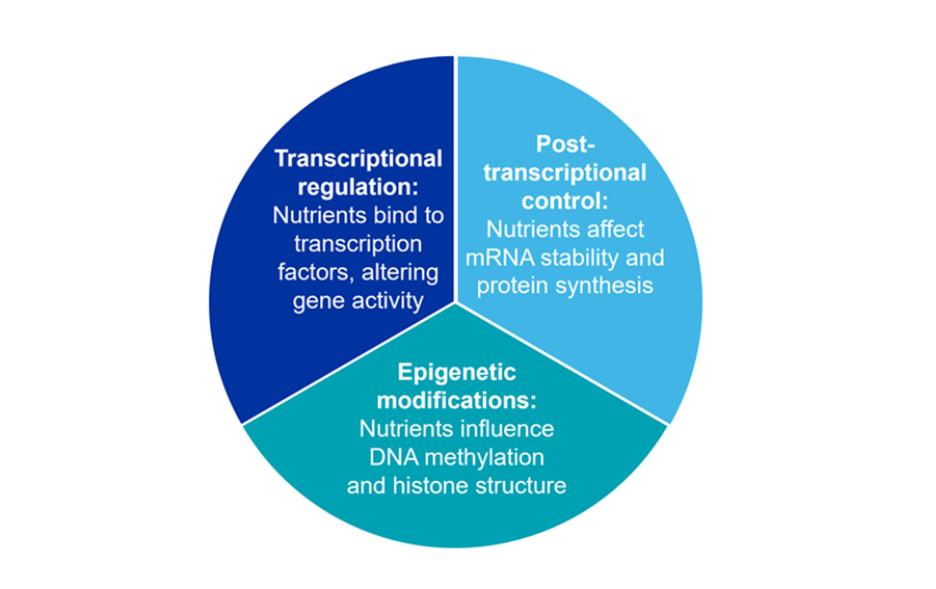In recent years, there has been a growing emphasis on the gut microbiome and its role in overall human health. Relatedly, animal health is increasingly being understood through the lens of this complex ecosystem of microorganisms that plays a pivotal role in digestion, immunity, and disease resistance. People are concerned about antibiotic usage in livestock that become our food sources, as well as animal welfare and the health of our pets — all of which are related to the gut microbiome.
As a result, researchers are exploring ways to protect and enhance animal health through feeding and therapeutic strategies, some of which are similar to the market for human microbiome supports, and some that are novel to the animal kingdom.
The foundation of animal health
The gut microbiome comprises trillions of microorganisms including bacteria, archaea, viruses, and fungi that reside in the digestive tract. These microbes play essential roles in nutrient digestion, immune system development, and protection against pathogens. A balanced microbiome supports feed efficiency, growth, and resilience in livestock and companion animals (see Figure 1). Disruptions in microbial balance, known as dysbiosis, are linked to gastrointestinal disorders, metabolic diseases, and reduced productivity.

We analyzed the CAS Content CollectionTM, the largest human-curated repository of scientific information, and found a remarkable evolution in the research landscape pertaining to the animal gut microbiome. From 2005 to 2024, there has been a consistent upward trend in journal publications in this field (see Figure 2). The inset comparison shows that pets have slightly more publications overall than livestock, and journal articles consistently outnumber patents in both categories.

This demonstrates the increased focus on pet health in recent years and that most research in this field has not reached commercialization. However, various therapeutic strategies are gaining traction based on our analysis. As we see in Figure 3A, many diseases are associated with gut microbiome dysbiosis, with gastrointestinal, metabolic, and immune-related conditions being the most documented. Figure 3B highlights therapeutic strategies aimed at restoring microbial balance, with probiotics and prebiotics receiving the highest research attention. This comparison underscores the growing scientific interest in microbiome-targeted interventions for diverse health conditions.

For example, in livestock such as cattle, poultry, pigs, and small ruminants, gut health is closely linked to feed efficiency, weight gain, reproductive success, and disease resistance. In companion animals like dogs and cats, the microbiome affects not only digestion and immunity but also mood, behavior, skin condition, and overall vitality. Dysbiosis in pets has been associated with chronic conditions including obesity, allergies, inflammatory bowel disease, bowel cancer, and anxiety, highlighting the microbiome’s broad impact on animal nutrition and quality of life.
Current therapeutic approaches to modulate gut microbiota
When the gut microbiome becomes imbalanced due to factors like antibiotic use, poor diet, stress, or infections, it can lead to dysbiosis, which manifests as gastrointestinal disturbances, inflammation, metabolic issues, and weakened immunity. Several therapeutic strategies have emerged to address dysbiosis:
Probiotics and prebiotics
Probiotics — live beneficial microbes such as lactobacillus, bifidobacterium, and enterococcus — play a vital role in enhancing animal gut health. They help restore microbial balance, suppress pathogens, improve nutrient absorption, and reduce gastrointestinal disturbances, especially during stress, dietary transitions, and early development. Studies in calves, piglets, and yaks have shown that probiotic-rich diets improve intestinal morphology, microbial diversity, immune responses, and growth performance, while also reducing inflammation and supporting digestion. Such evidence demonstrates the potential of probiotics and symbiotics to promote antibiotic-free livestock production and optimize gut microbiota for overall animal health.
Prebiotics, such as fructooligosaccharides (FOS), inulin, and mannan-oligosaccharides (MOS), are non-digestible dietary fibers that selectively stimulate the growth of beneficial gut bacteria. Their fermentation by gut microbes leads to the production of short-chain fatty acids (SCFAs), notably butyrate, acetate, and propionate, which play a critical role in maintaining gut barrier integrity, reducing inflammation, and supporting metabolic health.
Postbiotics
Postbiotics, which are metabolites or structural components produced by probiotics such as lactic acid and peptides, offer a stable, non-living alternative for enhancing animal health. When added to feed, they can modulate mucosal and systemic immune responses, supporting gut integrity and reducing inflammation. A recent clinical trial by Admixture Research Company demonstrated the potential of postbiotics in companion animal health. In adult dogs, the heat-treated postbiotic form of Bifidobacterium animalis subsp. lactis CECT 8145 (PRIOME® MH) significantly reduced postprandial blood glucose levels during a weight loss phase, suggesting its role in supporting metabolic health.
Fecal microbiota transplantation
Fecal microbiota transplantation (FMT) is gaining recognition as a valuable therapeutic tool in veterinary medicine, with applications across companion and livestock animals. In dogs and cats, FMT has shown promise in treating gastrointestinal disorders like antibiotic-associated diarrhea, chronic diarrhea, and inflammatory bowel disease (IBD), significantly improving clinical symptoms and restoring microbial balance (Ref). In livestock, FMT has been explored in ruminants like calves and dairy cows to manage diarrhea and even improve udder health and milk quality in cases of subclinical mastitis. In swine, particularly young pigs, FMT has been effective in reducing post-weaning diarrhea, enhancing weight gain, and improving gut microbiota composition. These applications highlight FMT’s potential to improve animal health, productivity, and welfare.
Phage therapy
Bacteriophage therapy is an emerging alternative to antibiotics in treating bacterial infections due to their multiple advantages as adaptative drugs. These include their high specificity and their ability to evolve and multiply at the site of infections. Promising applications include the prevention of mastitis in cattle caused by Staphylococcus aureus, mitigation of salmonellosis in swine due to Salmonella enteritidis, and control of Campylobacter jejuni and Salmonella Gallinarum in poultry. Recent advances in genetic engineering, particularly the integration of CRISPR/Cas9 systems, have further enhanced the precision and efficacy of phage therapy.
Next-generation therapeutics: Tackling antimicrobial resistance
As seen in current therapeutic approaches like pre- and probiotics, addressing the use of antibiotics and related antibiotic resistance is important. Antimicrobial resistance (AMR) impacts food security, human health, and veterinary care because the gut microbiome serves as a key reservoir for antimicrobial resistant genes (ARGs). The widespread misuse of antimicrobials in livestock and companion animals has accelerated resistance, with Asia accounting for 67% of the estimated 99,500 tons of global veterinary antimicrobial use in 2020. This figure is projected to rise by 8% by 2030, underscoring the need for urgent, coordinated interventions that consider the complex interplay between antimicrobial use, gut microbiome disruption, and resistance development.
Research efforts have intensified in response, as reflected in a steady rise in AMR-related publications within the CAS Content Collection over the past two decades (see Figure 4). Various innovative strategies are now in development.

Sustainability-focused interventions
Microbiome-focused treatments may help improve animal health and environmental sustainability simultaneously. A study demonstrated that certain gut bacteria could absorb and eliminate per- and polyfluoroalkyl substances (PFAS), a class of persistent environmental pollutants. In mice, these microbes reduced systemic PFAS levels by up to 75%, suggesting a promising avenue for detoxification strategies in animals.
Another groundbreaking development is using CRISPR technology to engineer probiotics that reduce methane emissions in cattle. Since methane, a potent greenhouse gas, is primarily produced by methanogenic archaea in the rumen, modifying the microbial composition early in life could significantly lower emissions without affecting productivity, offering a sustainable solution for the livestock industry. This microbiome-based intervention offers a sustainable strategy for the livestock industry, especially given that livestock emissions contribute approximately 14.5% of global greenhouse gas emissions.
Longevity
A recent study examined gut microbial profiles in rabbits and found that certain microbes, such as Akkermansia and Christensenellaceae, were associated with longer reproductive lifespans and greater resilience. These findings suggest that microbiome-based selection or supplementation could be integrated into breeding programs to enhance longevity and productivity. By leveraging tools such as CAS Scientific Patent ExplorerTM, we identified several patents showing increased commercial interest in this field.
For example, a recent patent covered stabilized probiotic formulations for pet food that improve palatability and health outcomes. Other patents focus on multi-strain probiotics and therapeutic approaches for correcting dysbiosis in livestock and companion animals. An additional patent outlines a microbial-nutrient blend designed to enhance gut health and animal performance.
Novel antibiotic classes
Recent discoveries are introducing new antimicrobial agents with broad-spectrum activity and minimal toxicity that aim to preserve beneficial gut microbiota while targeting pathogens. One such example is Lariocidin, a newly identified lasso peptide that demonstrates potent efficacy in animal models and shows promise in overcoming resistance mechanisms. Similarly, a bioactive protein from Sydney rock oysters has been found to disrupt bacterial biofilms and enhance antibiotic effectiveness against drug-resistant Staphylococcus aureus and Pseudomonas aeruginosa without observed toxicity or major microbiome perturbations.
Antimicrobial photodynamic therapy
Antimicrobial photodynamic therapy (aPDT) is a novel approach that uses a photosensitizer activated by light in the presence of oxygen to produce reactive oxygen species (ROS), which effectively kill pathogens. In veterinary medicine, aPDT has shown promise in treating mastitis in cattle and sheep, as well as skin infections and otitis in small animals. Studies have demonstrated its efficacy against various mastitis-causing bacteria and multidrug-resistant strains. However, limitations include the topical nature of photosensitizer application due to systemic light sensitivity and potential toxicity, which require further investigation before broader use in animal health.
Antimicrobial peptides
Antimicrobial peptides (AMPs) are gaining attention as innovative alternatives to conventional antibiotics in livestock and pet care. These peptides, classified into non-ribosomally and ribosomally synthesized types, exhibit potent bactericidal activity against numerous pathogens. Non-ribosomal AMPs like polymyxin and bacitracin target bacterial membranes and cell wall synthesis, while ribosomally synthesized AMPs, including bacteriocins such as nisin and pediocin, disrupt key biosynthetic pathways and cellular processes. Their biodegradability, minimal environmental impact, and compatibility with other treatments make them attractive candidates for feed additives and therapeutic agents. Despite these advantages, however, challenges such as high production costs, narrow antibacterial spectra, potential toxicity, and stability issues during administration and transport remain. Advances in genetic and protein engineering are helping address these limitations, paving the way for AMPs to play a more prominent role in sustainable animal health management.
Immunomodulatory strategies
Enhancing the natural immune system of animals through immunomodulatory strategies offers a promising alternative to traditional antimicrobial approaches. Key methods include the use of pro-, pre-, post-, and syn-biotics, which support a healthy gut microbiome and bolster resistance to harmful pathogens. Immunostimulants are also employed to activate and strengthen immune responses, thereby reducing reliance on antibiotics. Additionally, targeted vaccination programs play a crucial role in preventing infections caused by resistant pathogens, offering proactive protection and contributing to overall herd health and disease management.
Phytochemicals
Phytochemicals are plant-derived bioactive compounds with proven health benefits. Their antimicrobial properties, along with their ability to enhance nutrient absorption, improve gut health, and reduce spoilage, make them promising natural alternatives to antibiotics in ruminant, swine, and poultry production.
Nanoparticles
Nanoparticles are emerging as promising alternatives to antibiotics in animal health due to their unique antimicrobial mechanisms and physicochemical properties. Silver, copper, and composite nanoparticles have shown strong in vitro efficacy against pathogens causing mastitis, uterine infections, and hoof diseases in dairy cattle. Their ability to disrupt bacterial membranes, generate reactive oxygen species, and damage intracellular structures offers a novel approach to combat drug-resistant microbes. While early studies suggest safety at low concentrations, concerns about cytotoxicity and bioaccumulation highlight the need for further in vivo research before widespread veterinary application.
Ozone therapy
Ozone therapy is gaining attention as a safe and effective alternative to antibiotics in veterinary medicine. Its strong oxidizing properties enable it to kill bacteria by disrupting cell membranes and DNA, while also offering immunomodulatory and antioxidant effects at low doses. Used in cattle, sheep, goats, and horses, ozone has shown success in treating mastitis, metritis, and reproductive disorders without leaving residues in milk or meat, thus avoiding withdrawal periods.
Nutrigenetics: Feeding by design
Whether in humans or animals, diet is closely linked to gut microbiome health. Nutrigenetics, the study of how genetic variations influence an animal's response to nutrients, is transforming animal health services by enabling precision nutrition tailored to genetic profiles. Essentially, this approach recognizes that individual genetic variations affect how animals metabolize nutrients and respond to dietary interventions, with direct implications for microbiome diversity and antimicrobial resistance gene prevalence.
At the molecular level, nutrients interact with genes through various mechanisms (see Figure 5). Understanding these mechanisms allows for the development of targeted diets that support optimal gene expression, physiological performance, and beneficial microbiome composition while reducing the selective pressure for antimicrobial resistance.

Figure 5: Molecular mechanisms through which nutrients interact with genes.
Applications and health benefits
- Livestock: Nutrigenetics has found extensive applications in livestock, offering targeted nutritional strategies that align with genetic profiles to improve health and productivity. Research has revealed that host genetics can influence gut microbial composition with specific genetic variations affecting feed efficiency through microbiome-mediated pathways. In poultry, genetic profiling has enabled the formulation of feeds that enhance growth rates, feed conversion efficiency, and immune resilience while promoting beneficial microbial communities that resist pathogen colonization. In swine, nutrigenetic approaches have helped identify pigs with superior nutrient utilization traits, allowing for precision feeding that supports reproductive performance and reduces waste. Similarly, in dairy cattle, genotype-based diets have been shown to improve milk yield and reduce the incidence of metabolic disorders such as ketosis and acidosis. Expanding beyond traditional livestock, sheep and goats are being studied for nutrigenetic traits that influence reproductive efficiency, immune function, and adaptation to nutrient-scarce environments.
- Equines: Nutrigenetics is being explored in horses to manage metabolic syndromes, support performance in sport horses, and prevent conditions like laminitis through tailored nutrition strategies. These applications are relevant in competitive and therapeutic settings, where optimal health and recovery are essential.
- Companion animals: Nutrigenetics is gaining traction for managing breed-specific health conditions in dogs and cats, such as obesity, food allergies, and metabolic disorders. Personalized diets based on genetic predispositions are being developed to improve longevity and overall wellness. These approaches also support immune and digestive health, contributing to better quality of life and reduced veterinary interventions.
Looking ahead, the successful integration of nutrigenetics into animal nutrition will depend on several strategic priorities: simplifying genetic screening processes, developing scalable and adaptable feeding models that consider microbiome interactions, expanding research to include underrepresented species, and establishing clear regulatory frameworks. By embracing these advancements, producers, veterinarians, and pet owners can transition from generic feeding approaches to precision nutrition strategies that align with each animal’s genetic potential and health needs.
Gut health means overall animal well-being
Advancing animal health requires a holistic approach that integrates gut microbiome science, nutrigenetic insights, and innovative alternatives to antimicrobial resistance. Together, these domains offer powerful tools to enhance immunity, optimize nutrition, and reduce dependence on antibiotics. As we continue to understand the importance of the gut microbiome, new findings will be applied not only to human health, but to the food sources and companion animals that interact with us and our environment.








